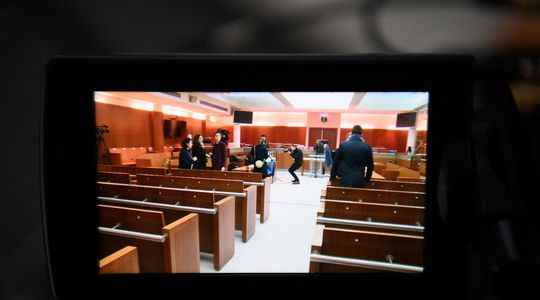Writhing hands. Worn hands, sometimes a little dirty, with black fingernails and badly healed wounds. Hands that say a lot about these men prosecuted in court and of which we will see nothing but nervous extremities. Hands that take place in an almost unprecedented experience in France, the broadcasting of images of recent trials on television. Wednesday evening, October 19, France 3 launches, in fact, a series of documentaries entitled “Justice filmed in France”. The first episode takes place at the Aix-en-Provence Court of Appeal to follow two cases. One concerns a man prosecuted for drunken driving and violence against his partner and son. The second, a repairman tried for manslaughter after the death of the passenger of a motorcycle on which he intervened shortly before.
The filming of these documentaries was made possible by the law for confidence in the judicial institution of 2021. Initiated by Eric Dupond-Moretti, the idea aroused much debate, protests and concerns. Precautions were imposed by the Ministry of Justice: prior consent and before dissemination, cases definitively judged, right to be forgotten after 5 or 10 years. Under these conditions, it is now possible to record, film and broadcast hearings for a “pedagogical reason” whereas until then, filming in the courtrooms was only authorized in very exceptional circumstances, “for history”. This is how the trial of November 13 was, years after that of Klaus Barbie and a few others, recorded but the distribution of the images will not be authorized for decades.
Thirty years after “Justice in France”
We remember that in 1991, Daniel Karlin and Tony Lainé had delivered a formidable work which was already called “Justice in France”. Nine 90-minute episodes for which they had set up their cameras in different locations and followed procedures from start to finish. Those who take the time to watch the current series of France 3 will rediscover the feeling of being immersed in the heart of a judicial machine that we know little about. We discover magistrates who are sometimes condescending towards defendants who show by their language and their elocution how far this world is from the one in which they live. We observe a justice that oscillates between emotions and coldness, between boredom and the desire to educate. We listen to lawyers more or less prepared to defend what is not really defensible. Between two sequences from the hearings, the legal columnist Dominique Verdeilhan, a lawyer and a magistrate shed light on what we have just seen: what is a court of appeal? A prosecutor? A probationary period? The desire to do educational work is so present that this aspect ends up taking precedence over the hearing extracts. These are too short for us to fully understand what is being played out in the courtroom. The choice to begin the series with a court of appeal rather than hearings at first instance does not facilitate the civic lesson.
Laetitia Ohnona’s documentary, broadcast in August by LCP and devoted to a departmental criminal court, escaped this pitfall. He was only interested in one case, that of incest, on a 52-minute format. A pace that left time to show without voyeurism what a trial for rape. In particular, when it comes to a seven-year-old child and a father suspected of incest. But also the difficulties in obtaining evidence and the essential delicacy of a president on such a heavy subject. Time finally to question this new form of justice. Until then experimental, generalized in 2023, the departmental criminal courts are to replace the assize courts to judge predefined facts. It is then five professional magistrates who rule in place of the popular jurors. Between two excerpts from the hearing, each of the actors (president of the court, lawyers for the defense and civil parties, prosecutor, etc.) gives their opinion on what this court changes in the course of a trial. Are there more acquittals? Less emotion? Don’t we hear fewer witnesses and experts? Is justice really done so well? We will not have a definitive answer, but important questions are being asked.
All these films and documentaries aim to “bring justice into the homes of the French”. Will they make it? One cannot help doubting with regard to the broadcast schedule chosen by France 3, 11 p.m. on a Wednesday evening. On the channel side, we will undoubtedly retort that it is a good window and that there is always the possibility of seeing the film via the replay platform. Not false. But to convince the public to abandon the addictive crime series, where often Anglo-Saxon inspired justice is a theater, the jurors, twelve in a box after swearing on the Bible to tell the whole truth, nothing but the truth , one wonders if it would not have taken more solemnity and ambition for the first broadcast. We will see if these works, which have not been unworthy, far from it, manage to achieve their primary goal: to reach all French people and not just those who are already interested in justice.
